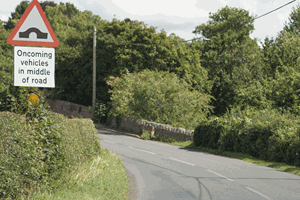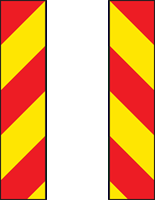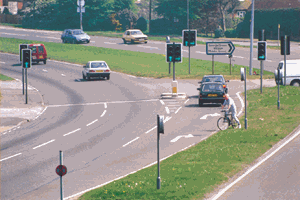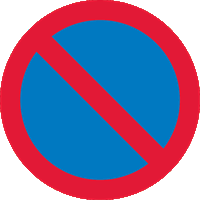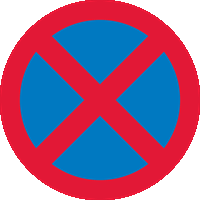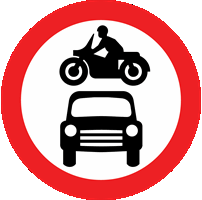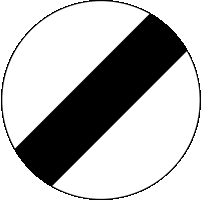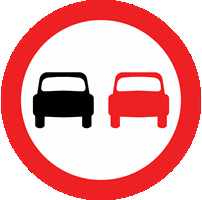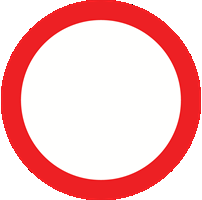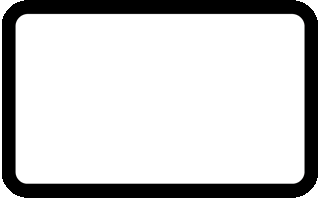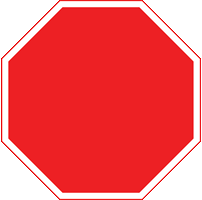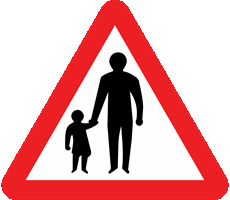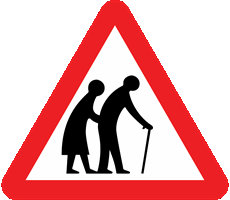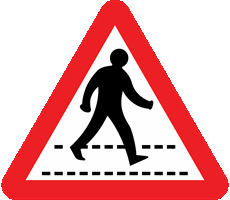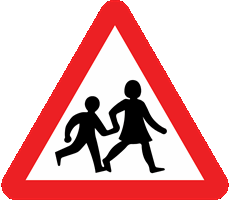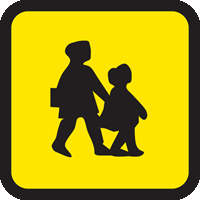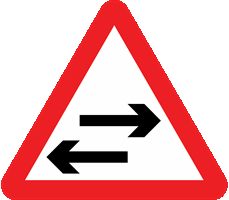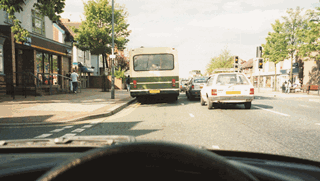You have 57 minutes to answer 50 multiple choice driving theory test questions. You need to answer at least 43 out of 50 questions correctly to pass. You can review your answer after each question or you can review all of your answers at the end of the test. Best of luck!
Test Quick View
Click on an answer to view the correct choice along with the explanation.
Correct Answer: D
Explanation: This sign gives you a warning. The brow of the hill prevents you seeing oncoming traffic so you must be cautious. The bridge is narrow and there may not be enough room for you to pass an oncoming vehicle at this point. There is no footpath, so pedestrians may be walking in the road. Consider the hidden hazards and be ready to react if necessary.
Explanation: This sign gives you a warning. The brow of the hill prevents you seeing oncoming traffic so you must be cautious. The bridge is narrow and there may not be enough room for you to pass an oncoming vehicle at this point. There is no footpath, so pedestrians may be walking in the road. Consider the hidden hazards and be ready to react if necessary.
یہ علامات آپ کو خبردار کرتی ہیں کہ پہاڑی کا حصہ آپ کو آنے والی ٹریفک کو دیکھنے سے روکتا ہے۔ اس لئے آپ کو محتاط رہنا ہوگا۔پل تنگ ہے اور ہوسکتا ہے کہ یہاں پر سامنے سے آنے والی ٹریفک کے ساتھ گزرنے کی جگہ نہ ہو۔ یہاں کوئی فٹ پاتھ نہیں اس لئے راہگیر سڑک پر چل رہے ہوں گے۔چھپے ہوئے خطرات کا دھیان رکھیں اور اگر ضروری ہو تو ردعمل کے لئے تیار رہیں۔
Correct Answer: A
Explanation: Pelican crossings are signal-controlled crossings operated by pedestrians. Push-button controls change the signals. Pelican crossings have no red-and-amber stage before green. Instead, they have a flashing amber light, which means you MUST give way to pedestrians already on the crossing, but if it is clear, you may continue.
Explanation: Pelican crossings are signal-controlled crossings operated by pedestrians. Push-button controls change the signals. Pelican crossings have no red-and-amber stage before green. Instead, they have a flashing amber light, which means you MUST give way to pedestrians already on the crossing, but if it is clear, you may continue.
پیلیکن کراسنگز سگنل کنٹرول کراسنگز ہیں جو راہگیر چلتے ہیں بٹن دبانے سے اشارے تبدیل ہوجاتے ہیں۔ پیلیکن کراسنگ پر سبز سے پہلے سرخ اور پیلی بتی نہیں ہوتی ہے بلکہ ایک فیلش کرتی ہوئی پیلی بتی ہوتی ہے جس کا مطلب ہے کہ آپ کو کراسنگ پر پہلے سے موجود راہگیروں کو راستہ دینا چاہئے لیکن اگر یہ خالی ہیں تو آپ جاسکتے ہیں
Correct Answer: A
Explanation: Your horn mustn't be used between 11.30 pm and 7 am in a built-up area or when you're stationary, unless a moving vehicle poses a danger. Its function is to alert other road users to your presence.
Explanation: Your horn mustn't be used between 11.30 pm and 7 am in a built-up area or when you're stationary, unless a moving vehicle poses a danger. Its function is to alert other road users to your presence.
4. You're in a one-way street and want to turn right. There are two lanes. Where should you position your vehicle?
Mark one answer
B
C
D
Correct Answer: C
Explanation: When you're in a one-way street and want to turn right, you should take up a position in the right-hand lane. This will allow other road users, not wishing to turn, to pass on the left. Indicate your intention and take up the correct position in good time.
Explanation: When you're in a one-way street and want to turn right, you should take up a position in the right-hand lane. This will allow other road users, not wishing to turn, to pass on the left. Indicate your intention and take up the correct position in good time.
5. You wish to turn right ahead. Why should you take up the correct position in good time?
Mark one answer
B
C
D
Correct Answer: D
Explanation: If you wish to turn right into a side road, take up your position in good time. Move to the centre of the road when it's safe to do so. This will allow vehicles to pass you on the left. Early planning will show other traffic what you intend to do.
Explanation: If you wish to turn right into a side road, take up your position in good time. Move to the centre of the road when it's safe to do so. This will allow vehicles to pass you on the left. Early planning will show other traffic what you intend to do.
Correct Answer: B
Explanation: These markers must be fitted to vehicles over 13 metres long, large goods vehicles, and rubbish skips placed in the road. They're reflective to make them easier to see in the dark.
Explanation: These markers must be fitted to vehicles over 13 metres long, large goods vehicles, and rubbish skips placed in the road. They're reflective to make them easier to see in the dark.
Correct Answer: B
Explanation: Look at the picture carefully and try to imagine you're there. The cyclist in this picture appears to be trying to cross the road. You must be able to deal with the unexpected, especially when you're approaching a hazardous junction. Look well ahead to give yourself time to deal with any hazards.
Explanation: Look at the picture carefully and try to imagine you're there. The cyclist in this picture appears to be trying to cross the road. You must be able to deal with the unexpected, especially when you're approaching a hazardous junction. Look well ahead to give yourself time to deal with any hazards.
8. A driver pulls out of a side road in front of you, causing you to brake hard. What should you do?
Mark one answer
B
C
D
Correct Answer: B
Explanation: Be tolerant if a vehicle emerges and you have to brake quickly. Anyone can make a mistake, so don't react aggressively. Be alert where there are side roads and be especially careful where there are parked vehicles, because these can make it difficult for emerging drivers to see you.
Explanation: Be tolerant if a vehicle emerges and you have to brake quickly. Anyone can make a mistake, so don't react aggressively. Be alert where there are side roads and be especially careful where there are parked vehicles, because these can make it difficult for emerging drivers to see you.
9. You see a pedestrian carrying a white stick with a red band. What does this tell you?
Mark one answer
B
C
D
Correct Answer: D
Explanation: When someone is deaf as well as blind, they may carry a white stick with a red reflective band. They may not be aware that you're approaching and they may not be able to hear anything; so, for example, your horn would be ineffective as a warning to them.
Explanation: When someone is deaf as well as blind, they may carry a white stick with a red reflective band. They may not be aware that you're approaching and they may not be able to hear anything; so, for example, your horn would be ineffective as a warning to them.
10. You're coming up to a roundabout. A cyclist is signalling to turn right. What should you do?
Mark one answer
B
C
D
Correct Answer: B
Explanation: If you're following a cyclist who's signalling to turn right at a roundabout, leave plenty of room. Give them space and time to get into the correct lane.
Explanation: If you're following a cyclist who's signalling to turn right at a roundabout, leave plenty of room. Give them space and time to get into the correct lane.
B
C
D
Correct Answer: D
Explanation: Cyclists and motorcyclists are smaller than other vehicles and so are more difficult to see. They can easily be hidden from your view by cars parked near a junction.
Explanation: Cyclists and motorcyclists are smaller than other vehicles and so are more difficult to see. They can easily be hidden from your view by cars parked near a junction.
Correct Answer: C
Explanation: Pedestrians and riders on two wheels can be harder to see than other road users. Make sure you look for them, especially at junctions. Effective observation, coupled with appropriate action, can save lives.
Explanation: Pedestrians and riders on two wheels can be harder to see than other road users. Make sure you look for them, especially at junctions. Effective observation, coupled with appropriate action, can save lives.
Correct Answer: A
Explanation: Don't overtake if there's a possibility of a road junction, bend or brow of a bridge or hill ahead. There are many hazards that are difficult to see in the dark. Only overtake if you're certain that the road ahead is clear. Don't take a chance.
Explanation: Don't overtake if there's a possibility of a road junction, bend or brow of a bridge or hill ahead. There are many hazards that are difficult to see in the dark. Only overtake if you're certain that the road ahead is clear. Don't take a chance.
14. Which of these isn't allowed to travel in the right-hand lane of a three-lane motorway?
Mark one answer
B
C
D
Correct Answer: D
Explanation: A vehicle with a trailer is restricted to 60 mph. For this reason, it isn't allowed in the right-hand lane, as it might hold up faster-moving traffic that wishes to overtake in that lane.
Explanation: A vehicle with a trailer is restricted to 60 mph. For this reason, it isn't allowed in the right-hand lane, as it might hold up faster-moving traffic that wishes to overtake in that lane.
Correct Answer: D
Explanation: This sign indicates that there are waiting restrictions. It's normally accompanied by details of when the restrictions are in force. Details of most signs in common use are shown in The Highway Code. For more comprehensive coverage, see Know Your Traffic Signs.
Explanation: This sign indicates that there are waiting restrictions. It's normally accompanied by details of when the restrictions are in force. Details of most signs in common use are shown in The Highway Code. For more comprehensive coverage, see Know Your Traffic Signs.
Correct Answer: B
Explanation: When going straight ahead at a roundabout, don't signal as you approach it. Indicate left just after passing the exit before the one you wish to take.
Explanation: When going straight ahead at a roundabout, don't signal as you approach it. Indicate left just after passing the exit before the one you wish to take.
B
C
D
Correct Answer: D
Explanation: By standing on the pavement, the pedestrian is showing an intention to cross. By looking well ahead, you'll give yourself time to see the pedestrian, check your mirrors and respond safely.
Explanation: By standing on the pavement, the pedestrian is showing an intention to cross. By looking well ahead, you'll give yourself time to see the pedestrian, check your mirrors and respond safely.
Correct Answer: B
Explanation: You'll generally see this sign at the approach to a pedestrian-only zone.
Explanation: You'll generally see this sign at the approach to a pedestrian-only zone.
Correct Answer: D
Explanation: To make it easy to recognise, the 'stop' sign is the only sign of this shape. You must stop and take effective observation before proceeding.
Explanation: To make it easy to recognise, the 'stop' sign is the only sign of this shape. You must stop and take effective observation before proceeding.
Correct Answer: A
Explanation: When you pass pedestrians in the road, leave plenty of room. You might have to use the right-hand side of the road, so look well ahead, as well as in your mirrors, before pulling out. Take great care if a bend in the road obscures your view ahead.
Explanation: When you pass pedestrians in the road, leave plenty of room. You might have to use the right-hand side of the road, so look well ahead, as well as in your mirrors, before pulling out. Take great care if a bend in the road obscures your view ahead.
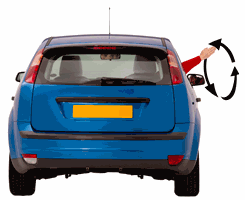
B
C
D
Correct Answer: A
Explanation: There might be an occasion where another driver uses an arm signal. This may be because the vehicle's indicators are obscured by other traffic. In order for such signals to be effective, all drivers should know their meaning. Be aware that the 'left turn' signal might look similar to the 'slowing down' signal.
Explanation: There might be an occasion where another driver uses an arm signal. This may be because the vehicle's indicators are obscured by other traffic. In order for such signals to be effective, all drivers should know their meaning. Be aware that the 'left turn' signal might look similar to the 'slowing down' signal.
Correct Answer: D
Explanation: Watch out for children crossing the road from the other side of the bus.
Explanation: Watch out for children crossing the road from the other side of the bus.
23. You're following a cyclist. What should you do when you wish to turn left just ahead?
Mark one answer
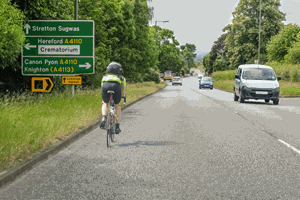
B
C
D
Correct Answer: B
Explanation: Make allowances for cyclists, and give them plenty of room. Don't overtake and then immediately turn left. Be patient and turn behind them when they've passed the junction.
Explanation: Make allowances for cyclists, and give them plenty of room. Don't overtake and then immediately turn left. Be patient and turn behind them when they've passed the junction.
24. You're travelling along a street with parked vehicles on the left-hand side. Why should you keep your speed down?
Mark one answer
B
C
D
Correct Answer: A
Explanation: Travel slowly and carefully near parked vehicles. Beware of
- vehicles pulling out, especially bicycles and motorcycles
- pedestrians, especially children, who may run out from between cars
- drivers opening their doors
Explanation: Travel slowly and carefully near parked vehicles. Beware of
- vehicles pulling out, especially bicycles and motorcycles
- pedestrians, especially children, who may run out from between cars
- drivers opening their doors
Correct Answer: A
Explanation: Although a convex mirror gives a wide view of the scene behind, you should be aware that it won't show you everything behind or to the side of your vehicle. Before you move off, you'll need to look over your shoulder to check for anything not visible in the mirrors.
Explanation: Although a convex mirror gives a wide view of the scene behind, you should be aware that it won't show you everything behind or to the side of your vehicle. Before you move off, you'll need to look over your shoulder to check for anything not visible in the mirrors.
Correct Answer: D
Explanation: Different coloured beacons warn of different types of vehicle needing special attention. Blue beacons are used on emergency vehicles that need priority. Green beacons are found on doctors' cars. Amber beacons generally denote slower moving vehicles, which are often large. These vehicles are usually involved in road maintenance or local amenities and make frequent stops.
Explanation: Different coloured beacons warn of different types of vehicle needing special attention. Blue beacons are used on emergency vehicles that need priority. Green beacons are found on doctors' cars. Amber beacons generally denote slower moving vehicles, which are often large. These vehicles are usually involved in road maintenance or local amenities and make frequent stops.
Correct Answer: B
Explanation: Top up the battery with distilled water and make sure each cell plate is covered.
Explanation: Top up the battery with distilled water and make sure each cell plate is covered.
Correct Answer: C
Explanation: This distance is the equivalent of 18 car lengths. Try pacing out 73 metres and then look back. It's probably further than you think.
Explanation: This distance is the equivalent of 18 car lengths. Try pacing out 73 metres and then look back. It's probably further than you think.
Correct Answer: A
Explanation: You should normally travel in the left-hand lane unless you're overtaking a slower-moving vehicle. When you've finished overtaking, move back into the left-hand lane, but don't cut across in front of the vehicle that you've overtaken.
Explanation: You should normally travel in the left-hand lane unless you're overtaking a slower-moving vehicle. When you've finished overtaking, move back into the left-hand lane, but don't cut across in front of the vehicle that you've overtaken.
30. You're travelling along a motorway. When are you allowed to overtake on the left?
Mark one answer
B
C
D
Correct Answer: A
Explanation: Never overtake on the left, unless the traffic is moving in queues and the queue on your right is moving more slowly than the one you're in.
Explanation: Never overtake on the left, unless the traffic is moving in queues and the queue on your right is moving more slowly than the one you're in.
Correct Answer: A
Explanation: Be prepared for traffic approaching from junctions on either side of you. Try to avoid unnecessary changing of lanes just before the junction.
Explanation: Be prepared for traffic approaching from junctions on either side of you. Try to avoid unnecessary changing of lanes just before the junction.
Correct Answer: C
Explanation: No-one likes to spend time in traffic queues. Try to avoid busy times related to school or work travel.
Explanation: No-one likes to spend time in traffic queues. Try to avoid busy times related to school or work travel.
Correct Answer: B
Explanation: If possible, avoid the early morning, late afternoon and early evening 'rush hour'. Doing this should allow you to travel in a more relaxed frame of mind, concentrate solely on what you're doing and arrive at your destination feeling less stressed.
Explanation: If possible, avoid the early morning, late afternoon and early evening 'rush hour'. Doing this should allow you to travel in a more relaxed frame of mind, concentrate solely on what you're doing and arrive at your destination feeling less stressed.
Correct Answer: D
Explanation: You must use parking lights when parking at night on a road or in a lay-by on a road with a speed limit greater than 30 mph. You must also park in the direction of the traffic flow and not close to a junction.
Explanation: You must use parking lights when parking at night on a road or in a lay-by on a road with a speed limit greater than 30 mph. You must also park in the direction of the traffic flow and not close to a junction.
Correct Answer: A
Explanation: There are some crossings where cycle routes lead cyclists to cross at the same place as pedestrians. These are called toucan crossings. Always look out for cyclists, as they're likely to be approaching faster than pedestrians.
Explanation: There are some crossings where cycle routes lead cyclists to cross at the same place as pedestrians. These are called toucan crossings. Always look out for cyclists, as they're likely to be approaching faster than pedestrians.
36. You intend to turn left at the traffic lights. What should you do just before turning?
Mark one answer
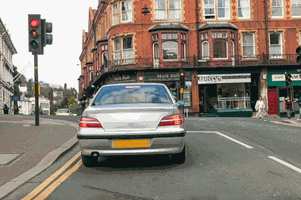
B
C
D
Correct Answer: A
Explanation: Check your nearside for cyclists before moving away. This is especially important if you've been in a queue of traffic and are about to move off, as cyclists often filter past on the nearside of stationary vehicles.
Explanation: Check your nearside for cyclists before moving away. This is especially important if you've been in a queue of traffic and are about to move off, as cyclists often filter past on the nearside of stationary vehicles.
B
C
D
Correct Answer: B
Explanation: You aren't fit to drive if you're taking medicine that makes you drowsy. Check with your doctor if you're unsure. You mustn't put other road users, your passengers or yourself at risk.
Explanation: You aren't fit to drive if you're taking medicine that makes you drowsy. Check with your doctor if you're unsure. You mustn't put other road users, your passengers or yourself at risk.
Correct Answer: D
Explanation: If you have to park your vehicle in foggy conditions, try to find a place to park off the road. If this isn't possible, park on the road facing in the same direction as the traffic. Leave your sidelights switched on and make sure they're clean.
Explanation: If you have to park your vehicle in foggy conditions, try to find a place to park off the road. If this isn't possible, park on the road facing in the same direction as the traffic. Leave your sidelights switched on and make sure they're clean.
Correct Answer: C
Explanation: Unless exempt, you and your passengers must wear a seat belt (or suitable child restraint). The seat belts in your car must be in good condition and working properly; they'll be checked during its MOT test.
Explanation: Unless exempt, you and your passengers must wear a seat belt (or suitable child restraint). The seat belts in your car must be in good condition and working properly; they'll be checked during its MOT test.
40. You're reversing your vehicle into a side road. When would the greatest hazard to passing traffic occur?
Mark one answer
B
C
D
Correct Answer: D
Explanation: Always check in all directions before reversing into a side road. Keep a good lookout throughout the manoeuvre. Act on what you see and wait if necessary.
Explanation: Always check in all directions before reversing into a side road. Keep a good lookout throughout the manoeuvre. Act on what you see and wait if necessary.
Correct Answer: B
Explanation: Briefly using your hazard warning lights will warn the traffic travelling behind you that there's a hazard ahead. This can reduce the chance of vehicles crashing into the back of each other.
Explanation: Briefly using your hazard warning lights will warn the traffic travelling behind you that there's a hazard ahead. This can reduce the chance of vehicles crashing into the back of each other.
Correct Answer: A
Explanation: If you want to turn your car around, try to find a place where you have good all-round vision. If this isn't possible, and you're unable to see clearly, then get someone to guide you.
Explanation: If you want to turn your car around, try to find a place where you have good all-round vision. If this isn't possible, and you're unable to see clearly, then get someone to guide you.
B
C
D
Correct Answer: C
Explanation: When driving a motor car, a learner driver who holds a provisional driving licence must
- display red L plates (or D plates in Wales) to the front and rear of the vehicle
- be insured to drive the vehicle
- be accompanied by someone who's at least 21 years old and who has held for at least three years (and still holds) a full licence for the category of vehicle being driven.
Explanation: When driving a motor car, a learner driver who holds a provisional driving licence must
- display red L plates (or D plates in Wales) to the front and rear of the vehicle
- be insured to drive the vehicle
- be accompanied by someone who's at least 21 years old and who has held for at least three years (and still holds) a full licence for the category of vehicle being driven.
Correct Answer: D
Explanation: Although carbon dioxide is still produced, a catalytic converter fitted to the exhaust system reduces the toxic and polluting gases by up to 90%.
Explanation: Although carbon dioxide is still produced, a catalytic converter fitted to the exhaust system reduces the toxic and polluting gases by up to 90%.
45. What will happen if you hold the clutch pedal down or roll in neutral for too long?
Mark one answer
B
C
D
Correct Answer: C
Explanation: Holding the clutch down or staying in neutral for too long will cause your vehicle to freewheel. This is known as 'coasting' and it's dangerous because it reduces your control of the vehicle.
Explanation: Holding the clutch down or staying in neutral for too long will cause your vehicle to freewheel. This is known as 'coasting' and it's dangerous because it reduces your control of the vehicle.
46. You're towing a trailer along a three-lane motorway. When may you use the right-hand lane?
Mark one answer
B
C
D
Correct Answer: B
Explanation: If you're towing a caravan or trailer, you mustn't use the right-hand lane of a motorway with three or more lanes except in certain specified circumstances, such as when lanes are closed.
Explanation: If you're towing a caravan or trailer, you mustn't use the right-hand lane of a motorway with three or more lanes except in certain specified circumstances, such as when lanes are closed.
47. While you're driving, a warning light on your vehicle's instrument panel comes on. What should you do?
Mark one answer
B
C
D
Correct Answer: A
Explanation: Make sure you know what the different warning lights mean. An illuminated warning light could mean that your car is unsafe to drive. If you aren't sure about the problem, get a qualified mechanic to check it.
Explanation: Make sure you know what the different warning lights mean. An illuminated warning light could mean that your car is unsafe to drive. If you aren't sure about the problem, get a qualified mechanic to check it.
48. You claim on your insurance to have your car repaired. Your policy has an excess of £100. What does this mean?
Mark one answer
B
C
D
Correct Answer: C
Explanation: Having an excess on your policy will help to keep the premium down. However, if you make a claim, you'll have to pay the excess yourself - in this case, £100.
Explanation: Having an excess on your policy will help to keep the premium down. However, if you make a claim, you'll have to pay the excess yourself - in this case, £100.
Correct Answer: B
Explanation: You should always try to keep junctions clear. If you're in queuing traffic, make sure that when you stop you leave enough space for traffic to flow into and out of the junction.
Explanation: You should always try to keep junctions clear. If you're in queuing traffic, make sure that when you stop you leave enough space for traffic to flow into and out of the junction.
B
C
D
Correct Answer: A
Explanation: As the driver, it's your responsibility to make sure that children are secure and safe in your vehicle. Make yourself familiar with the rules. In a few very exceptional cases when a child restraint isn't available, an adult seat belt must be used.
Explanation: As the driver, it's your responsibility to make sure that children are secure and safe in your vehicle. Make yourself familiar with the rules. In a few very exceptional cases when a child restraint isn't available, an adult seat belt must be used.



